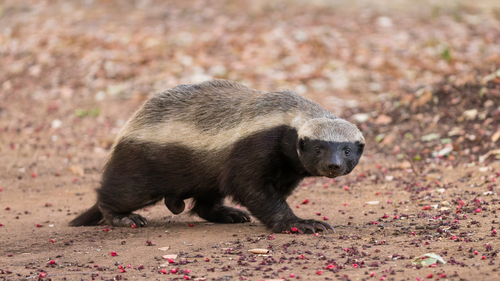
Honey Badger
Meet Mellivora capensis, the fearless honey badger. With a tenacious spirit, it thrives in diverse habitats, using its sturdy body and claws to hunt and scavenge. Known for its daring nature, this remarkable creature plays a vital role in controlling prey populations, showcasing adaptability and resilience in the wild.
7-8 years
Lifespan
4.99 - 15.88 kg
Weight
Length: 56 - 76 cm; Height: 23 - 28 cm
Size
1-2 years
Age of Sexual Maturity
2-3 Months
Age of Weaning
Least Concern
Conservation Status
Decreasing
Population Trend
Characteristics
The honey badger, known for its fierce temperament, inhabits a wide range of environments across Africa, Southwest Asia, and the Indian subcontinent. It boasts a stocky build, thick skin, and sharp claws, allowing it to be a formidable predator and scavenger. Notorious for its fearlessness, it can fend off larger predators.
Distribution Range of the Honey Badger
Mellivora capensis, commonly known as the honey badger, is native to Africa, the Middle East, and the Indian subcontinent. Its geographical distribution includes countries throughout sub-Saharan Africa, extending to parts of the Arabian Peninsula and India. Notably, the species ranges from Morocco and Senegal in the west to South Africa in the south, and eastward to Eritrea, Ethiopia, and Somalia. In the Middle East, it is found in countries like Saudi Arabia, Yemen, and Oman, while in South Asia, it is present in India and parts of Pakistan.
Honey Badger's Habitat
Environmental Conditions
The honey badger inhabits a variety of environments, including dry forests, savannas, grasslands, and even mountainous regions up to 2600 meters above sea level. It is highly adaptable to different climates, from hot deserts to more temperate areas. The species typically avoids dense rainforests and prefers open or lightly wooded areas where it can forage effectively.
Ecological Niche
As a carnivorous mammal, the honey badger is an opportunistic feeder with a diet that includes small mammals, birds, insects, and reptiles, as well as honey, which it is famously known for raiding from beehives. It plays a crucial role in its ecosystem by controlling the populations of its prey and facilitating seed dispersal through its foraging activities. The honey badger is known for its remarkable resilience and adaptability, often thriving in challenging environments due to its fearless and tenacious nature.
Copyright @ Nature Style Limited. All Rights Reserved.
 English
English